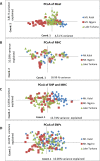Genetic diversity and population structure of African village dogs based on microsatellite and immunity-related molecular markers
- PMID: 29940023
- PMCID: PMC6016929
- DOI: 10.1371/journal.pone.0199506
Genetic diversity and population structure of African village dogs based on microsatellite and immunity-related molecular markers
Abstract
The village and street dogs represent a unique model of canine populations. In the absence of selective breeding and veterinary care, they are subject mostly to natural selection. Their analyses contribute to understanding general mechanisms governing the genetic diversity, evolution and adaptation. In this study, we analyzed the genetic diversity and population structure of African village dogs living in villages in three different geographical areas in Northern Kenya. Data obtained for neutral microsatellite molecular markers were compared with those computed for potentially non-neutral markers of candidate immunity-related genes. The neutral genetic diversity was similar to other comparable village dog populations studied so far. The overall genetic diversity in microsatellites was higher than the diversity of European pure breeds, but it was similar to the range of diversity observed in a group composed of many European breeds, indicating that the African population has maintained a large proportion of the genetic diversity of the canine species as a whole. Microsatellite marker diversity indicated that the entire population is subdivided into three genetically distinct, although closely related subpopulations. This genetical partitioning corresponded to their geographical separation and the observed gene flow well correlated with the communication patterns among the three localities. In contrast to neutral microsatellites, the genetic diversity in immunity-related candidate SNP markers was similar across all three subpopulations and to the European group. It seems that the genetic structure of this particular population of Kenyan village dogs is mostly determined by geographical and anthropogenic factors influencing the gene flow between various subpopulations rather than by biological factors, such as genetic contribution of original migrating populations and/or the pathogen-mediated selection. On the other hand, the study of oldest surviving dogs suggested a biological mechanism, i.e. a possible advantage of the overal heterozygosity marked by the the microsatellite loci analyzed.
Conflict of interest statement
The authors have declared that no competing interests exist.
Figures






Similar articles
-
The effects of dog breed development on genetic diversity and the relative influences of performance and conformation breeding.J Anim Breed Genet. 2013 Jun;130(3):236-48. doi: 10.1111/jbg.12017. Epub 2012 Dec 6. J Anim Breed Genet. 2013. PMID: 23679949
-
Complex population structure in African village dogs and its implications for inferring dog domestication history.Proc Natl Acad Sci U S A. 2009 Aug 18;106(33):13903-8. doi: 10.1073/pnas.0902129106. Epub 2009 Aug 3. Proc Natl Acad Sci U S A. 2009. PMID: 19666600 Free PMC article.
-
Phylogenetic distinctiveness of Middle Eastern and Southeast Asian village dog Y chromosomes illuminates dog origins.PLoS One. 2011;6(12):e28496. doi: 10.1371/journal.pone.0028496. Epub 2011 Dec 14. PLoS One. 2011. PMID: 22194840 Free PMC article.
-
Schistosome genetic diversity: the implications of population structure as detected with microsatellite markers.Parasitology. 2002;125 Suppl:S51-9. doi: 10.1017/s0031182002002020. Parasitology. 2002. PMID: 12622328 Review.
-
Development of DNA-based microsatellite marker technology for studies of genetic diversity in stressor impacted populations.Ecotoxicology. 2001 Aug;10(4):229-32. doi: 10.1023/a:1016621511695. Ecotoxicology. 2001. PMID: 11501433 Review.
Cited by
-
Genetic Structure of the Ca Rater Mallorquí Dog Breed Inferred by Microsatellite Markers.Animals (Basel). 2022 Oct 11;12(20):2733. doi: 10.3390/ani12202733. Animals (Basel). 2022. PMID: 36290119 Free PMC article.
-
Kazakh national dog breed Tazy: What do we know?PLoS One. 2023 Mar 8;18(3):e0282041. doi: 10.1371/journal.pone.0282041. eCollection 2023. PLoS One. 2023. PMID: 36888576 Free PMC article.
-
Comparison of sensitization patterns to dust mite allergens between atopic dermatitis patients and dogs, and non-specific reactivity of canine IgE to the storage mite Tyrophagus putrescentiae.Exp Appl Acarol. 2022 Sep;88(1):41-55. doi: 10.1007/s10493-022-00744-5. Epub 2022 Oct 3. Exp Appl Acarol. 2022. PMID: 36190668
-
Translating Pharmacogenetics and Pharmacogenomics to the Clinic: Progress in Human and Veterinary Medicine.Front Vet Sci. 2019 Feb 11;6:22. doi: 10.3389/fvets.2019.00022. eCollection 2019. Front Vet Sci. 2019. PMID: 30854372 Free PMC article. Review.
References
-
- Vila C, Savolainen P. Multiple and ancienit origins of the domestic dog. Science.1997; 276: 1687–1689. - PubMed
-
- Lindblad-Toh K, Wade CM, Mikkelsen TS, Karlsson EK, Jaffe DB, Kamal M, et al. Genome sequence, comparative analysis and haplotype structure of the domestic dog. Nature. 2005; 438: 803–819. doi: 10.1038/nature04338 - DOI - PubMed
-
- Von Holdt BM, Pollinger JP, Lohmueller KE, Han E, Parker HG, Quignon P, et al. Genome-wide SNP and haplotype analyses reveal a rich history underlying dog domestication. Nature. 2010; 464: 898–902. doi: 10.1038/nature08837 - DOI - PMC - PubMed
-
- Larson G, Karlsson EK, Perri A, Webster MT, Ho SYW, Peters J, et al. Rethinking dog domestication by integrating genetics, archeology and biogeography. Proceedings of the National Academy of Sciences of the United States of America. 2012; 109: 8878–8883. doi: 10.1073/pnas.1203005109 - DOI - PMC - PubMed
Publication types
MeSH terms
Substances
LinkOut - more resources
Full Text Sources
Other Literature Sources

